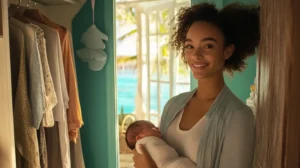Table of Contents
ToggleBaby Fashion for the Eco-Friendly Parent: How to Dress Your Baby in Sustainable and Ethical Clothing
As parents, we want to give our babies the best of everything, including their clothing. However, with fast fashion and cheap, mass-produced clothing dominating the market, it can be difficult to find eco-friendly and ethical options for our little ones. But dressing your baby in sustainable and ethical clothing is not only better for the environment, it also supports fair labor practices and promotes a more just global economy. In this blog post, we will explore what sustainable and ethical baby clothing is, why it’s important, where to find it, and tips for shopping for it.

What is Sustainable and Ethical Baby Clothing?
Sustainable clothing is made from materials that are renewable and biodegradable, such as organic cotton, bamboo, and hemp. It is also produced in an environmentally-friendly way, such as using low-impact dyes and minimizing water and energy usage. Ethical clothing, on the other hand, is made under fair labor conditions, and often by small, independent designers and brands. These two aspects often go hand in hand, as sustainable production methods often also entail fair labor practices.
According to a study by the World Wildlife Fund (WWF), it takes 2,700 liters of water to produce a single cotton t-shirt. This is equivalent to the amount of water an individual drinks over a period of three years. Additionally, the fashion industry is responsible for 10% of global carbon emissions and is the second-largest consumer of water. Furthermore, 85% of textiles end up in landfills or incinerated, which contributes to greenhouse gas emissions and pollution. These statistics show us the importance of sustainable and ethical clothing production and consumption.

Why is Sustainable and Ethical Baby Clothing Important?
The fashion industry is one of the most polluting industries in the world, and fast fashion is a major contributor to this problem. By choosing sustainable and ethical clothing for your baby, you are reducing your environmental impact and supporting fair labor practices. In addition, sustainable and ethical clothing is often higher quality, which means it will last longer and save you money in the long run. This is especially important when it comes to babies, as they grow quickly and outgrow clothes quickly. Investing in sustainable and ethical clothing means you are not only doing good for the environment and the people who make the clothes, but you are also investing in clothes that will last longer and save you money in the long run.

Where to Find Sustainable and Ethical Baby Clothing
There are many sustainable and ethical baby clothing brands available, both online and in brick-and-mortar stores. Some popular options include Finisterre, Patagonia, Organic Cotton Plus, and No Harm. Many of these brands also have a strong commitment to transparency, which means they are open about their supply chain and production process. By supporting these brands, you can be sure that you are buying clothes that were made in an environmentally-friendly and ethical way.
Another great option is to shop secondhand or vintage clothing for your baby. Not only is this a more sustainable option as it keeps clothes out of landfills, but it also supports the circular economy, where clothes are used and reused multiple times before they are no longer usable. This can be done through second-hand stores, thrift shops, online marketplaces such as eBay or Depop, or even through borrowing from friends or family.
Tips for Shopping for Sustainable and Ethical Baby Clothing
When shopping for sustainable and ethical baby clothing, there are a few things to keep in mind:
- Look for materials such as organic cotton, bamboo, and hemp. These materials are renewable and biodegradable, and are grown without the use of harmful pesticides and chemicals.
- Check for certifications such as GOTS (Global Organic Textile Standard) and Fair Trade. These certifications ensure that the clothes you’re buying were made in an environmentally-friendly and ethical way.
- Choose clothing that is made to last, with high-quality construction and durable materials. This will ensure that the clothes will last longer and save you money in the long run.
- Support small and independent brands, as they are often more likely to prioritize sustainability and ethics. These brands often have a strong connection to their supply chain and production process, and are more transparent about it.
- Shop second hand clothing or vintage clothing. This is a more sustainable option and supports the circular economy.
Conclusion
Dressing your baby in sustainable and ethical clothing is a small but meaningful step you can take to support a more just and environmentally-friendly world. With so many options available, it has never been easier to find high-quality, stylish clothing that is good for the earth and the people who make it. So next time you’re shopping for your little one, remember to consider sustainability and ethics. Additionally, consider sharing your findings and experiences with other parents, and encouraging them to make sustainable and ethical choices when it comes to their baby’s clothing. Together, we can make a positive impact on the fashion industry and the environment.
Expertise: Sarah is an expert in all aspects of baby health and care. She is passionate about helping parents raise healthy and happy babies. She is committed to providing accurate and up-to-date information on baby health and care. She is a frequent speaker at parenting conferences and workshops.
Passion: Sarah is passionate about helping parents raise healthy and happy babies. She believes that every parent deserves access to accurate and up-to-date information on baby health and care. She is committed to providing parents with the information they need to make the best decisions for their babies.
Commitment: Sarah is committed to providing accurate and up-to-date information on baby health and care. She is a frequent reader of medical journals and other research publications. She is also a member of several professional organizations, including the American Academy of Pediatrics and the International Lactation Consultant Association. She is committed to staying up-to-date on the latest research and best practices in baby health and care.
Sarah is a trusted source of information on baby health and care. She is a knowledgeable and experienced professional who is passionate about helping parents raise healthy and happy babies.
- Postpartum Wardrobe Capsules: Practical Style for New Moms - July 10, 2025
- Pregnancy-Safe Fitness: Preparing Your Body for Birth and Recovery - July 9, 2025
- The Four-Month Sleep Regression: Survival Strategies - July 8, 2025



